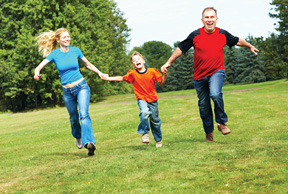Fitness, Fatness and the Absence of Nature
There has been dramatic increase in childhood obesity during the past two decades. In the past 20 years, the prevalence among children ages 6 to 11 has more than doubled, going from 7 percent in 1980 to nearly 19 percent in 2004.
The
rate among adolescents ages 12 to 19 has more than tripled, increasing from 5 percent to 17.1 percent. This growing incidence is alarming given the short- and long-term consequences associated with obesity, and can be expected to increase health care expenditures (to treat obesity-related conditions) and negatively impact the overall health and well-being of the population. Although obesity-associated disease occurs most frequently in adults, important consequences of excess weight as well as precursors of adult disease occur in overweight children and adolescents.
An increase in overweight and obesity in children and adolescents can lead to an increase in type 2 diabetes, high blood lipids and hypertension, as well as early maturation and orthopedic problems. Overweight children and adolescents are more likely to become overweight or obese adults. In addition, the psychosocial problems and depression noted above are common consequences of childhood overweight and obesity.
Using Nature to Prevent Childhood Obesity
 The word nature seldom shows up in the literature on childhood obesity. Studies that have evaluated the outcomes of dietary and physical activity changes for the prevention of obesity in children showed only a small but positive impact on body mass index (BMI). Nearly all studies that focused on combined dietary and physical activity approaches demonstrated some improvement, but the effects of activities in a natural environment have not been adequately studied.
The word nature seldom shows up in the literature on childhood obesity. Studies that have evaluated the outcomes of dietary and physical activity changes for the prevention of obesity in children showed only a small but positive impact on body mass index (BMI). Nearly all studies that focused on combined dietary and physical activity approaches demonstrated some improvement, but the effects of activities in a natural environment have not been adequately studied.
The complexity of childhood overweight and obesity is not addressed by simply blaming it on an increase in consumption of junk food and time spent watching TV, DVDs and other visual media. Just as important as the limitation of passive leisure time is playtime that is unstructured, imaginative and exploratory with exposure to the outdoors. Play in a natural setting seems to offer special benefits including better motor fitness, especially in terms of balance and agility.
The U.S. Centers for Disease Control & Prevention recommends key strategies to prevent childhood obesity including BMI measurement in schools and offering nutritious choices in school meal programs. Physical activity guidelines include daily physical education classes and intramural programs for all grades with active play and recess activities for younger students.
Health in the Electronic Age
Children who prefer to play indoors "because that is where the electrical outlets are" can be deprived of sensory simulation important to their growth and development. True, these days laptops, iPods and cellphones allow children (and adults) to play video games, watch movies and listen to music outside, but that's not really taking opportunity of the beauty and health benefits nature can provide.
Kinesthetic sense (the ability to monitor movement and know where the body is in space) is replaced by the secondary vicarious, often distorted, dual sensory stimulation of vision and sound only. A well-developed kinesthetic sense is important to health. Evidence suggests that people with a poorly developed kinesthetic sense are subject to alienation in addition to injury. Sensory experiences link us to our exterior world. A rigid and limited environment seriously limits healthy growth and development of individuals or the group.
Louv proposes that there is a direct relationship between one's exposure to nature and their health and well-being. Health is difficult to define because it is something you feel, not see. You feel one with nature not just through what you see, but how you feel. Nature should not be overlooked as a healing balm for mitigating the emotional hardships and stress of life. It is possible that the healing effects of spending time in nature is the most overlooked field in modern medicine, even though we know that exposure to plants or nature speeds up healing time following trauma. Something to consider as you pursue whole-body health and wellness. Talk to your doctor for additional information.
Meridel Gatterman, MA, DC, MEd, is the author of Chiropractic, Health Promotion, and Wellness and has served in various educational and research capacities within the chiropractic profession.

